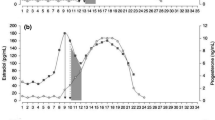Summary
Background: The onset of puberty is a period of rapid anatomical and physiological alterations expected to induce changes in metabolic rate and energy requirements of children.
Aim of the study: To evaluate the changes in anthropometrical features, body composition, physical capacities, and energy expenditure (EE) of boys and girls during the period of onset of puberty.
Methods: Sixteen children (8 boys and 8 girls were recruited in the same school-class and studied both at 10.4 and 12.8 years of age. Body composition was assessed by bioimpedance analysis. Peak oxygen uptake (peak VO2) was measured using an automated on-line system during exercising on a cycle ergometer. Energy expenditure (EE) was determined by whole-body indirect calorimetry over a 24-h period after a 12-h period of adaptation to the calorimeters. Volunteers followed the same activity programme that included four 15-min periods of exercise.
Results: During the onset of puberty, boys and girls gained 4.7±2.1 kg.y−1 (P < 0.0003) fat-free mass (FFM), whereas fat mass gain was 1.0±1.2 kg.y−1 (P < 0.05) in girls and 0.20±0.66 kg.y−1 in boys (NS). Peak VO2 adjusted for differences in FFM was not significantly affected by gender or pubertal stage. However, adjusted external mechanical power performed at peak VO2 was higher in pubertal than in prepubertal children, by 40% (P < 0.0001) and 22% (P < 0.003) in boys and girls, respectively. It was also 17% (P < 0.0002) higher in pubertal boys than in pubertal girls. Daily and sleeping EE increased by 38% and 32% in boys and girls, respectively, during the 2.4-y period (P < 0.0001). Adjusted EEs were also significantly higher in pubertal than in prepubertal boys (P < 0.05 and P < 0.03), but not in girls. The main significant determinants of daily EE were FFM (r2=0.866, P < 0.0001), peak VO2 (r2=0.017, P < 0.04), and age (r2=0.014, P < 0.05). Tanner's stage was an additional determinant of sleeping EE (r2=0.025, P < 0.006).
Conclusions: The increases in physical capacities and EE during the onset of puberty indicated clear gender differences, which could be explained mainly by alterations of body composition in boys and girls, and by changes in hormonal status in bouys. They also stressed the significant increase in energy requirements of children, especially boys, at an early stage of puberty.
Similar content being viewed by others
Author information
Authors and Affiliations
Additional information
Received: 23 July 1999, Accepted: 22 May 2000
Rights and permissions
About this article
Cite this article
Bitar, A., Vernet, J., Coudert, J. et al. Longitudinal changes in body composition, physical capacities and energy expenditure in boys and girls during the onset of puberty. Eur J Nutr 39, 157–163 (2000). https://doi.org/10.1007/s003940070019
Issue Date:
DOI: https://doi.org/10.1007/s003940070019




